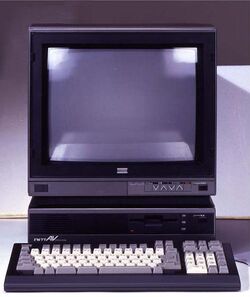| Fujitsu FM-7 | |
|---|---|
 A FM-7 (Model FM-77) computer. | |
|
Type: |
Home computer |
|
Release date: |
1982 |
|
Discontinued: |
1989 |
|
Operating system: |
F-BASIC |
|
CPU: |
Fujitsu MBL 68B09 |
|
Memory: |
64-448 KB |
The FM-7 (Acronim for Fujitsu Micro-7) is a home computer created by Fujitsu, first released in 1982 and only sold in Japan.
This model competed primarily with the NEC PC-8801 and Sharp X1 series of computers in the early 1980s. It was succeeded by the FM-77 series in 1984 (which were backwards compatible with the FM-7), and later the 32-bit FM Towns in 1989.
Hardware
Although it is known as a lower cost model, most notably removing its (expensive) bubble memory technology, the FM-7 was given a more advanced sound synthesizer, leading to a strong uptake among the hobbyist computer market in Japan and making it a more dominant system than its successor, the FM-8.
Processors
- Main CPU (Central Processing Unit) processor:
- 1982: Fujitsu MBL 68B09 (based on 8-bit Motorola 68B09) @ 4.9 - 8 MHz
- 1984: Fujitsu MBL 68B09 (based on 8-bit Motorola 68B09) @ 8 MHz
- 1985: Fujitsu MBL 68B09E (8-bit) @ 2 MHz (equivalent to MBL 68B09 @ 8 MHz)
- GPU (Graphics Processing Unit) processor:
- 1982: Fujitsu MBL 68B09 (based on 8-bit Motorola 68B09) @ 2 MHz
- 1984: Fujitsu MBL 68B09E (8-bit) @ 2 MHz
- 1985: Fujitsu MMR (Memory Mapping Register), Fujitsu MBL 68B09E (8-bit) @ 2 MHz
- Optional CPU processor: Zilog Z80 (8-bit)
Memory
- Main RAM (Random Access Memory)
- 1982: 64 KB
- 1984: 64-256 KB
- 1985: 128-256 KB
- 1986: 128 KB / 192 KB / 448 KB
- Video RAM (VRAM) memory:
- 1982: 48 KB
- 1985: 96 KB
- 1986: 96-144 KB
- 1987: 96-192 KB
- 1988: 192 KB
- ROM (Read-Only Memory) memory: 48 KB (1982), 72 KB (1985)
- Storage:
- Default: 10-20 MB hard disk drive (1982), 1x-2x 3.5" DD floppy disk drives (1984)
- Optional: Cassette tape, 5.25" floppy disk
- 3.5" DD (double-density) floppy disks: 320 KB each (1984), 640 KB each (1986)
Display
- Maximum display resolution: 640x200 pixels (1982), 640x400 pixels (1984)
- Maximum color palette: 8 (1982), 16 (1984), 4096 (1985), 262,144 (1986)
- Simultaneous display colors:
- 1982: 3 colors (monochrome), 8 colors (4-bit color)
- 1984: 8 colors at 640x200, 2 colors at 640x400
- 1985: 4096 colors at 320x200, 16 colors at 640x200, 2 colors at 640x400
- 1986: 4096 colors at 320x200, 16 colors at 640x200, 8 colors at 640x400
- 1987: 4096 colors at 320x200, 32 colors at 640x200, 16 colors at 640x400
- Monitors: Multi-monitor support for 2-6 monitors (1985)
- Video digitization: Supported (1985), Standard (1988)
Sound
- 1982: General Instruments AY-3-8910 sound chip (PSG synthesizer, 3 channels, 8 octaves)
- 1985: Yamaha sound board (FM synthesis, 3 channels), AY-3-8910 sound chip
Interface
- Interface: Tape, RGB, RS232, Joystick (2), ROM/RAM cartridges, BUS
Software
Its operative system, "F-BASIC", is an enhanced version of Microsoft's Color BASIC. F-BASIC's additions to the standard Microsoft CoCo BASIC include the Japanese character set (katakana, and a few kanji), block graphics, three-voice music, the ability to have graphics appear on the default text screen, and some neat commands such as being able to take any string and print it out in various sizes (from tiny to huge) and directions (forward, backward, up, down, etc.).
The Fujitsu FM-7 counts with a total of 161 games. Between the most popular for the system are the first Valis game, Ys I and II, and some based on famous animated series like Mobile Suit Gundam, Urusei Yatsura and Hokuto no Ken.
Models
FM-7 models included:
- FM-New 7 (1984)
- FM-77 (1984)
- FM-77 L2 (1985)
- FM-77 L4 (1985)
- FM-77 AV (1985)
- FM-77 AV20 (1986)
- FM-77 AV40 (1986)
- FM-77 AV20 EX (1987)
- FM-77 AV40 EX (1987)
- FM-77 AV40 SX (1988)
Trivia
- The Fujitsu computers were the only home computers with a Valis I version that didn't have an adaption for Valis II.